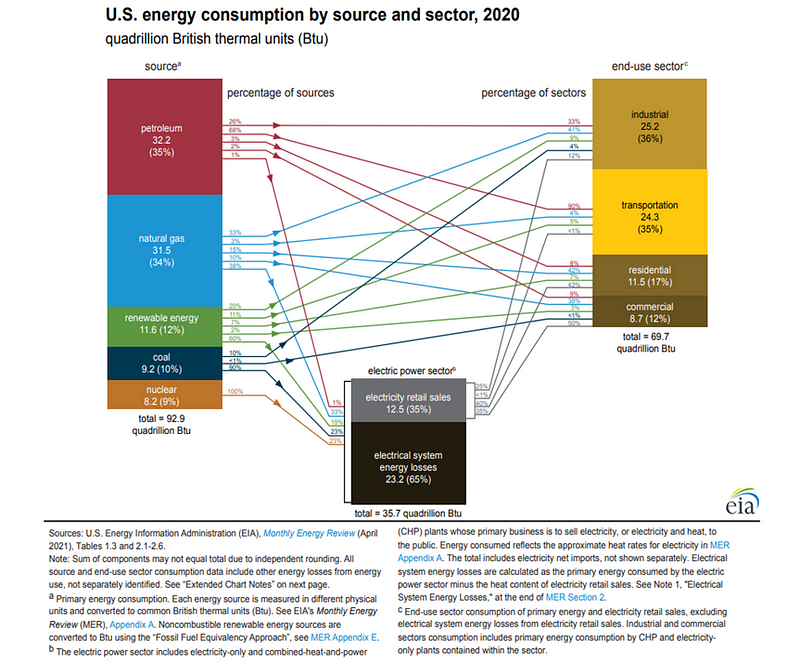Renewable Energy: The Future Beyond Fossil Fuels
Written on
The Promise of Renewable Energy
The transition from fossil fuels to renewable energy is not just a possibility; it's actively happening. Recent research from the Lawrence Berkeley National Laboratory highlights an astonishing development:
“In our analysis, we discovered that there are 1,400 gigawatts of proposed renewable energy generation and storage projects seeking to connect to the grid—this amount exceeds the total capacity of all existing power plants in the U.S.”
Currently, the total electricity generation capacity in the United States stands at 1,140 gigawatts, with renewables contributing 20% of that figure. This means that renewables currently generate around 228 gigawatts. With an additional 1,400 gigawatts of renewable projects in the pipeline, we could potentially reach a total capacity of 1,628 gigawatts—representing an increase of nearly 43% over today's total generation. This indicates that renewable generation could surpass current fossil fuel output by 143%. As advancements continue, the need for fossil fuels in electricity generation could become obsolete.
Batteries and Energy Storage Solutions
The study also revealed a growing trend among these projects to incorporate battery storage:
“Most of the new initiatives are solar-based, and over a third of them integrate hybrid solar with battery storage.”
Batteries are crucial for this transition. Today’s storage solutions often come in large shipping containers that are easily deployed by trucks and connected by electricians. While there are valid concerns regarding the environmental effects of batteries, innovative technologies are emerging to address these issues.
Among the promising developments are the Graphene aluminum ion battery and the cobalt-free lithium iron phosphate (LFP) battery, which Tesla has started using in half of its electric vehicles. These technologies are likely to become essential for large-scale, grid-connected projects and will evolve as they are further developed.
With such advancements, the skepticism surrounding the U.S.'s ability to transition its electricity generation to renewable sources—primarily wind and solar—can be alleviated. The projects that have recently applied for grid connection are sufficient to exceed our current energy needs.
Potential for Renewable Energy
The U.S. Energy Information Administration (EIA) provides a diagram illustrating this potential. The current capacity of 1,140 gigawatts corresponds to approximately 35.7 quadrillion Btu in the electric sector. If all proposed renewable projects come online, the total capacity could rise to 1,628 gigawatts, translating to about 51 quadrillion Btu. Given that the total energy production in the U.S. is 92.9 quadrillion Btu, nearly 55% of our energy requirements could be met by the projects already in development. Doubling this pipeline could potentially allow us to replace all energy sources with renewable electricity.

Empowering Change: What Consumers Can Do
Ultimately, the solution to climate change lies in the complete replacement of fossil fuels with renewable sources and the necessary battery storage. As consumers, we can play an active role in this transformation by electrifying our lives—this includes switching to electric appliances, heating systems, vehicles, and recreational devices like boats and ATVs. Every step taken toward electrification is a stride toward a sustainable future.
You can also subscribe to my newsletter, Intertwine: Living Better in a Worsening World.
Anthony Signorelli
Ideas and insights aimed at improving life in challenging times. My topics include Masculinity, Postcapitalism, Climate Change, Digital Innovations, Green Energy, and Financial Planning.
To support my work and explore more thought-provoking writing, consider joining Medium for just $5, where half of your subscription helps sustain my efforts. Thank you!
Chapter 2: The Cost of Energy Transition
The first video titled "Renewables vs. Fossil Fuels: The True Cost of Energy" explores the economic implications of shifting from fossil fuels to renewable sources. It delves into the actual costs associated with this transition, examining the financial benefits and challenges involved.
The second video, "Replacing Fossil Fuels with Renewables - What's Possible?" discusses the practicalities and potential outcomes of transitioning entirely to renewable energy. This video provides insights into what this shift could look like and the steps necessary to achieve it.